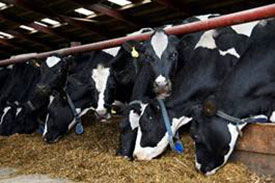
“Heat stress is a plague impacting dairy herds globally during hotter months. Not only is it detrimental to animal welfare, but it also impacts milk production, feed efficiency, overall health and even reproduction,” says Dr Richard Kirkland, ruminant nutritionist for Volac Wilmar Feed Ingredients. “Identification, diet and good management are all essential for combating this issue.”
For most cows, heat stress can begin at around 77°F. But more important than the external temperature is the combination of temperature and humidity.

“The higher the humidity, the more difficult it is for body heat to naturally dissipate despite sweating and panting. When humidity is involved, cows can suffer from heat stress at lower temperatures than usual, experiencing heat stress in the high 60s,” says Dr Kirkland.
Signs of heat stress
According to Dr Mike Hutjens, researcher and professor at the University of Illinois, USA, heat stressed dairy cattle are easy to identify with several clinical symptoms varying in degrees of severity.
One of the preliminary signs is a shift in behavior. Overheated cows will spend more of their time budget standing and seeking shade. When insufficient shade is provided for an entire group, this may cause individuals to clump together making it even more difficult to dissipate body heat.
Increased breathing is another evident sign of excessive heat.
“Typically, anything over 60 breaths per minute is a sign of heat stress,” says Dr Hutjens. “This can easily go as high as 80 or 90 breaths per minute (and) that can lead to panting.”
Maintenance requirements of heat-stressed cows can increase by up to 25 percent due to activities such as sweating and panting adds Dr Kirkland.
The cost of heat stress

A major effect of heat stress is reduced dry matter intake, with intakes typically reducing by 20 to 40 percent.
“The combination of lower dry matter intakes and increased maintenance requirements will quickly put a cow in an energy deficit,” says Dr Kirkland. “As a result, other functions including fertility and milk production are significantly reduced. According to various studies, conception rates can plummet to 10 percent during the hottest months of the year and milk yield by 35 percent.”
With altered intake and shifting maintenance requirements, milk composition also suffers. According to Dr Hutjens, this could be in the form of lower milk fat and protein content. Other less-considered consequences include an increase in the risk of lameness due to excessive standing, lower rumen pH and even smaller calf birthweights due to restricted uterine blood flow.
Feeding for energy density
Given the role of energy and feed intake in heat stress, amending the diet is not only necessary but also a part of the solution.
Digestion of feed requires energy and the process also generates heat internally.
“Good quality, highly-digestible forage should be offered to the highest yielding cows under the most stress, while digestible fibre sources such as sugarbeet pulp will help maintain production,” says Dr Kirkland. “Poor quality forage should be avoided as it requires a lot more work by the animal to chew and digest – generating greater internal heat production.”
Diets should also be supplemented with energy-dense nutrients such as rumen-protected fats. These boost energy supply without over-burdening the rumen with fermentation acids.
“Dietary fat undergoes minimal fermentation in the rumen and is used with much great efficiency than other sources of nutrients. The ME of a product like Calfat enables high energy density diets to be formulated to help ensure energy supply is increased even when total dry matter intake is low,” explains Dr Kirkland. “Rumen-protected fat is also more suitable to feed than cereals by not adding to the acid load in the rumen, which can increase risk of acidosis during heat stress conditions.”
“Fats are highly energetic, but it is the fatty acid make-up of the fat that will determine how the animal responds to the additional energy supplied,” he explains. “By understanding the impact these key fatty acids have on specific areas of performance, farmers can better target overall herd productivity.”
Remember the role of management
Besides diet, dairy producers should also be utilizing other management strategies to reduce the heat burden in their herds.
“Summer housing details should have adequate air circulation with fans, plus good ventilation and sprinklers,” concludes Dr Hutjens. “Extra care should be taken in the summer months to avoid over-crowding as much as possible. This means not overburdening freestalls and reducing time spent in holding pens as much as possible.”





